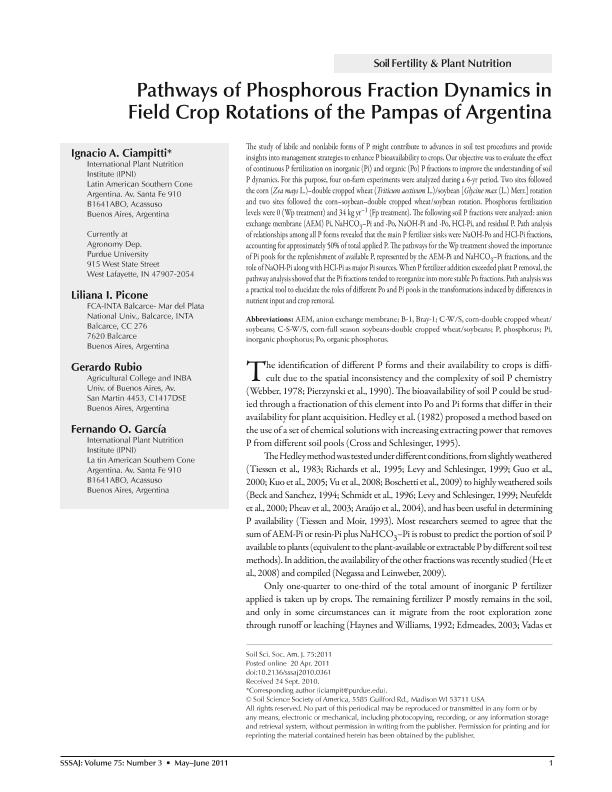Mostrar el registro sencillo del ítem
dc.contributor.author
Ciampitti, Ignacio A.
dc.contributor.author
Picone, Liliana Inés

dc.contributor.author
Rubio, Gerardo

dc.contributor.author
Garcia, Fernando Oscar

dc.date.available
2018-09-19T18:32:38Z
dc.date.issued
2011-05
dc.identifier.citation
Ciampitti, Ignacio A.; Picone, Liliana Inés; Rubio, Gerardo; Garcia, Fernando Oscar; Pathways of phosphorous fraction dynamics in field crop rotations of the pampas of Argentina; Soil Science Society of America; Soil Science Society of America Journal; 75; 3; 5-2011; 918-926
dc.identifier.issn
0361-5995
dc.identifier.uri
http://hdl.handle.net/11336/60268
dc.description.abstract
The study of labile and nonlabile forms of P might contribute to advances in soil test procedures and provide insights into management strategies to enhance P bioavailability to crops. Our objective was to evaluate the effect of continuous P fertilization on inorganic (Pi) and organic (Po) P fractions to improve the understanding of soil P dynamics. For this purpose, four on-farm experiments were analyzed during a 6-yr period. Two sites followed the corn (Zea mays L.)-double cropped wheat (Triticum aestivum L.)/soybean [Glycine max (L.) Merr.] rotation and two sites followed the corn-soybean-double cropped wheat/soybean rotation. Phosphorus fertilization levels were 0 (Wp treatment) and 34 kg yr -1 (Fp treatment). The following soil P fractions were analyzed: anion exchange membrane (AEM) Pi, NaHCO 3-Pi and -Po, NaOH-Pi and -Po, HCl-Pi, and residual P. Path analysis of relationships among all P forms revealed that the main P fertilizer sinks were NaOH-Po and HCl-Pi fractions, accounting for approximately 50% of total applied P. The pathways for the Wp treatment showed the importance of Pi pools for the replenishment of available P, represented by the AEM-Pi and NaHCO 3-Pi fractions, and the role of NaOH-Pi along with HCl-Pi as major Pi sources. When P fertilizer addition exceeded plant P removal, the pathway analysis showed that the Pi fractions tended to reorganize into more stable Po fractions. Path analysis was a practical tool to elucidate the roles of different Po and Pi pools in the transformations induced by differences in nutrient input and crop removal. © Soil Science Society of America.
dc.format
application/pdf
dc.language.iso
eng
dc.publisher
Soil Science Society of America

dc.rights
info:eu-repo/semantics/openAccess
dc.rights.uri
https://creativecommons.org/licenses/by-nc-sa/2.5/ar/
dc.subject
Fosoforo
dc.subject
Rotaciones
dc.subject
Soja
dc.subject
Maiz
dc.subject.classification
Agricultura

dc.subject.classification
Agricultura, Silvicultura y Pesca

dc.subject.classification
CIENCIAS AGRÍCOLAS

dc.title
Pathways of phosphorous fraction dynamics in field crop rotations of the pampas of Argentina
dc.type
info:eu-repo/semantics/article
dc.type
info:ar-repo/semantics/artículo
dc.type
info:eu-repo/semantics/publishedVersion
dc.date.updated
2018-09-12T19:11:17Z
dc.journal.volume
75
dc.journal.number
3
dc.journal.pagination
918-926
dc.journal.pais
Estados Unidos

dc.journal.ciudad
Madison
dc.description.fil
Fil: Ciampitti, Ignacio A.. International Plant Nutrition Institute; Argentina. Purdue University; Estados Unidos
dc.description.fil
Fil: Picone, Liliana Inés. Instituto Nacional de Tecnología Agropecuaria. Centro Regional Buenos Aires Sur. Estación Experimental Agropecuaria Balcarce; Argentina
dc.description.fil
Fil: Rubio, Gerardo. Consejo Nacional de Investigaciones Científicas y Técnicas. Oficina de Coordinación Administrativa Parque Centenario. Instituto de Investigaciones en Biociencias Agrícolas y Ambientales. Universidad de Buenos Aires. Facultad de Agronomía. Instituto de Investigaciones en Biociencias Agrícolas y Ambientales; Argentina
dc.description.fil
Fil: Garcia, Fernando Oscar. International Plant Nutrition Institute; Argentina
dc.journal.title
Soil Science Society of America Journal

dc.relation.alternativeid
info:eu-repo/semantics/altIdentifier/doi/https://dx.doi.org/10.2136/sssaj2010.0361
dc.relation.alternativeid
info:eu-repo/semantics/altIdentifier/url/https://dl.sciencesocieties.org/publications/sssaj/abstracts/75/3/918
Archivos asociados
